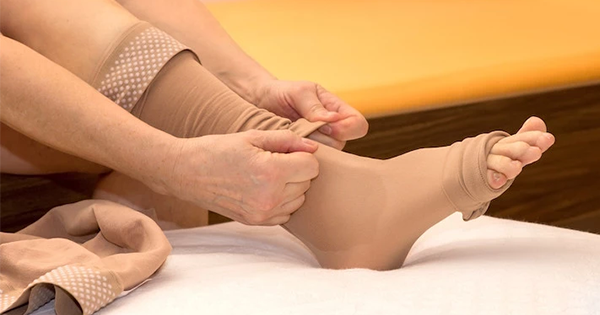This case highlights an elderly patient with complex skin needs requiring overnight compression.
Case presentation
Background
Bertha (not her real name) is an 81-year-old woman who lives alone. She is well supported by her two daughters and five grandchildren. She has been retired for more than 20 years and receives additional support to enable her to maintain her independence at home, including twice-daily nursing care and support with cleaning and gardening.
In 2016, she was diagnosed with sigmoid colon cancer and underwent a resection that included removal of 20 lymph nodes in her groin. Prior to this surgery, she had no lower limb swelling. Approximately 3 months after surgery, she began to experience swelling in her feet and ankles. Bandaging of her feet and ankles was initiated immediately to manage the swelling. After stabilisation, she was fitted with lower limb, class 1, closed toe compression stockings. She wore these every day and removed them overnight.
At the beginning of 2022, Bertha developed blisters which then progressed into ulcers on her left lower leg, and then later on her right lower leg. It was at this time that twice-daily nursing care at home was implemented, which included wound care, compression therapy with bandages, skin care and hygiene assistance.
Despite the application of topical corticoid medication, wound baths, bandaging, negative pressure wound therapy (NPWT) and manuka honey (Leptospermum scoparium, which has been shown to have antibacterial properties), the swelling continued to increase, and she had ongoing lymphorroea. The swelling progressively increased in both lower legs, with marked hardening of the skin. For approximately 12 months, she was not able to wear her usual compression garments and saw a deterioration in her mobility.
With symptomatic atrial fibrillation known since 2016, transthoracic echocardiography was regularly performed, last in May 2023. This exam revealed preserved systolic biventricular function, grade II diastolic left ventricular dysfunction, a significantly enlarged left atrium, but no evidence of pulmonary arterial pressure elevation, suggesting heart failure with preserved ejection fraction with aggravating peripheral oedema. She has been on anticoagulation therapy with apixaban for 1–2 years. Her sleep apnoea was difficult to treat with a ventilator because Bertha was frequently up at night to urinate.
In August 2023, Bertha was treated as an inpatient for erysipelas. She received antibiotic treatment, but had allergic reactions, including dyspnoea, to various antibiotic preparations. Following allergy tests, ciprofloxacin was prescribed successfully with no further allergic reactions reported.
Bertha was admitted to the Földiklinik in September 2023 for specialist treatment regarding her lymphoedema.
Assessment
Her medical history includes:
- Bilateral multicausal chronic lower limb lymphoedema, stage II with multiple skin erosions and lymphorrhoea.
- Grade III obesity (BMI 41.3 kg/m2).
- Erysipelas (most recently in August 2023).
- Sigmoid carcinoma with sigmoid resection 2016 and no radiotherapy or chemotherapy.
- Allergy to penicillin, amoxicillin, clindamycin and cephalosporins, with dyspnoea and skin exanthema.
- Arterial hypertension.
- Obstructive sleep apnoea syndrome.
- Heart failure with preserved ejection fraction.
- Persistent atrial fibrillation.
- Chronic renal insufficiency stage 3.
- Chronic venous insufficiency with ulceration.
- Folic acid deficiency.
She presented with stable weight and normal appetite. However, she reported dyspnoea on physical exertion as well as nocturia which she advised had been present for a long time. She reported infrequent alcohol consumption, no nicotine consumption and no ongoing pain. Of note, treatment with fentanyl patches at a dose of 12 ug/h was temporarily required in August 2023 due to significant pain
Her regular medications included L-thyroxin, enalapril, lercarnidipine, metoprolol succinate, torasemide, omeprazole, empagliflozine, atorvastatin and metamizole.
She presented with a generalised reduced physical condition. This was due to her being morbidly obese, and thus limited in mobility and resilience. In addition, she had increased urination at night with intermittent atrial fibrillation. She had compensated heart failure under medication-induced diuresis with little constant rest phases. A sleep apnoea device could not be used well, resulting in nocturnal oxygen deficiency and fatigue during the day. On clinical assessment, her vital signs were unremarkable (blood pressure 145/90 mmHg, pulse 84/min, temperature 37.0°C, SpO2 94% under room air). Her lymph nodes were not enlarged, palpable or tender, she had good pulmonary function, her heart sounds were arrhythmic, abdomen soft, bowel sounds regular and the pulses of the carotid, radial, femoral, dorsal pedis and posterior tibial arteries were palpable on all both sides. She was alert and oriented and able to provide accurate medical information.
Bertha had pronounced lymphoedema of both lower legs with increased hard connective tissue. She had deep pitting oedema on slight pressure with clear indurations. Her knee and upper leg were decontoured and her forefeet were marked with hard connective tissue (Figure 1). Stemmer’s sign, i.e. the inability to pinch the skin of the proximal phalanx of the second or third toe in patients with lymphoedema (Stemmer, 1976), was positive with hyperkeratosis of the toes, ball of the toes and sole of the foot. She also displayed box toe formation.
In addition, there was evidence of multiple superficial shallow skin erosions with lymphorrhoea on both lower legs as well as stasis dermatitis.
Treatment plan
Bertha remained an inpatient at the Földiklinik for a total of 6 weeks. She received intensive daily decongestive therapy including manual lymphatic drainage, fibrosis massage, compression bandaging and movement therapy. The compression bandages were required to be worn 20–22 hours per day. An additional daily wound therapy treatment was implemented due to the lymphorrhoea. This involved:
- ActiMaris wound irrigation solution.
- Cutimed Sorbact gel plus Resposorb plus gauze bandage if the ulcerations are coated, Cetuvit plus gauze bandage without coating.
- BetaGalen cream (topical corticoid) and/or MoliCare cream for the surrounding skin, and only Eucerin Repair cream as the wound progressed.
Outcomes
During this intensive lymphological therapy, skin instabilities and fluctuations occurred repeatedly despite reduced oedema and fibrosis (Figure 2). At times she needed to remove the bandages earlier; however, it became clear that she was unable to go for longer than approximately an hour without compression before her ankles and lower legs began to refill with fluid and her skin condition deteriorated. In addition, her reduced mobility saw a hardening of the skin of her inner thigh region requiring additional therapy to enable adequate lymphatic flow.
In addition to prophylactic antibiotics to prevent recurrence of erysipelas, a shock high-dose oral corticosteroids were prescribed for 7 days with consecutive tapering of the dose over several days to stabilise the skin and reduce the inflammation. This multimodal intensive lymphological/internal therapy resulted in an oedema reduction of over 1 litre in her left leg (Table 1), loosened the connective tissue indurations and stabilised the skin condition with no further lymphorrhoea (Figure 3).
As Bertha is unable to independently don and doff her compression garments, she relies on the support of her care workers who attend twice daily. The time that they attend each day is variable and it can be several hours after getting up before she is able to put on her compression garments. Likewise, they can come early in the afternoon/evening, leaving her for long periods of time with no compression.
Given the rapidity in which her legs deteriorated, Bertha required an appropriate solution overnight to enable adequate and ongoing compression for her legs. She was prescribed thigh-high Comfiwave garments (Haddenham Healthcare, Figure 4), which she was able to trial before discharge, with great success. She was able to independently don the garments and reported high comfort levels sleeping overnight. This was sustained after discharge.
Discussion
This case presented a significant challenge for the multidisciplinary team due to the medical complexities, reduced mobility, dependence on care workers and need for appropriate, ongoing compression. The key interventions employed as part of complex decongestive therapy were skin care/wound care delivered concurrently with manual lymphatic drainage (MLD) and compression via short-stretch bandaging, as well as movement and exercise (Lasinski et al, 2012; Michopoulos et al, 2020). MLD helps move lymph to functional drainage areas and subsequently reduces oedema (Ezzo et al, 2015). The compression therapy maintains the limb state and provides additional support for muscle pump during movement which promotes lymphatic flow, subsequently maximising skin function and capacity (Lymphoedema Framework, 2006).
While Bertha achieved excellent results in the clinic situation, being able to maintain the progress at home and prevent any future skin breakdown was a challenge, meaning that it was essential to find appropriate compression solutions for her was essential. In particular, appropriate nighttime compression was needed to ensure she did not have long periods without compression between care worker visits.
Compression therapy is one of the foundations of lymphoedema management (International Society of Lymphology, 2020; Moffatt et al, 2020). Compression using inelastic, short-stretch bandages is an effective way to reduce oedema and can also be used as an option overnight to maintain the limb (Lasinski et al, 2012, Moffatt et al, 2020). However, there are several challenges for the individual with maintaining bandages outside of the clinic situation. They can be time consuming to put on and require either a skilled lymphoedema therapist or for the patient to be able to complete this herself. Bertha’s age and physical stature prevented her from being able to sustain a forward posture to reach her toes and therefore independently complete bandaging. This was not deemed an appropriate overnight solution for her at home.
A potential alternative to bandages would be adjustable Velcro compression wraps (Mosti et al, 2015; Ochalek et al., 2023). These allow the individual to adjust the tightness in response to swelling or discomfort, thereby maintaining sufficient compression. In order to apply compression to the whole leg, multiple components are required (foot piece, leg piece, knee piece and thigh piece) and they can be difficult to place correctly on the limb. During her inpatient stay an adjustable compression wrap was trialled; however, Bertha was overwhelmed and not able to manage this on her own. They were deemed not to be the right solution for Bertha.
In search of an appropriate garment for her, it needed to be easy to don/doff, provide sufficient support for the full leg to ensure the inner thigh received compression and to promote lymphatic flow to the trunk. It needed to be simple to manage, affordable and be comfortable to allow her to sleep overnight. The Comfiwave garment from Haddenham Healthcare (Phillips and Lawrance, 2020) met all of the above criteria and was able to be tested before discharge to ensure it met her needs and she could manage it independently.
Conclusion
This case highlights the importance of the patient-therapist relationship in being able to adapt and respond to the changing needs of the patient. Based on objective measures, established trust and communication allow therapy to be directed to areas of most need while also balancing the management of symptoms and the practicalities of activities of daily living. The input of the lymphoedema therapist has been crucial for maintaining functional use of the limb in terms of range of movement and reducing overall oedema. While bandaging was effective as an intensive treatment period to reduce oedema and improve tissue quality, it was not something that Bertha could manage independently at home. She was at risk of being for long periods of time during the evening/night with no compression which would result in further oedema accumulation. A more robust form of compression therapy was required to ensure ongoing management of limb volume and skin health. This needed to be balanced with cost, wearability, ability to don/doff and capacity to adapt to fluctuating levels of oedema.





